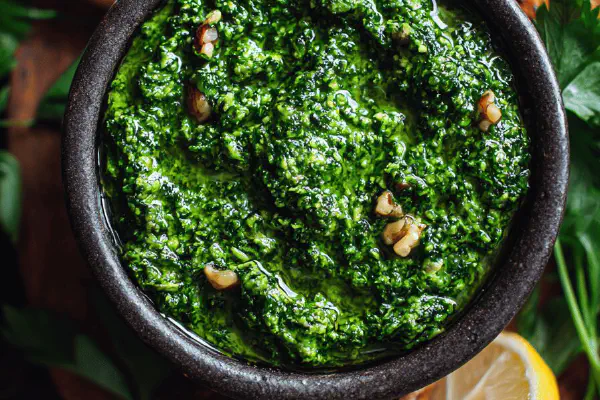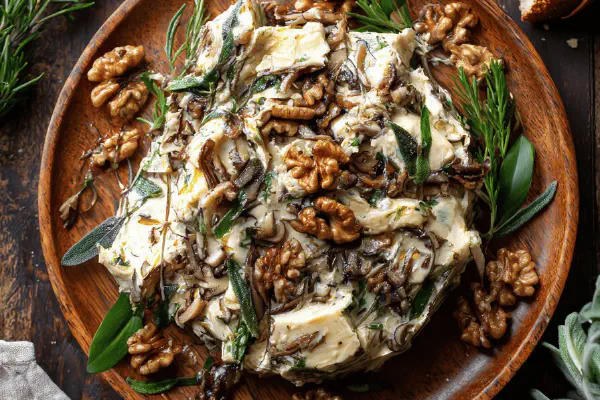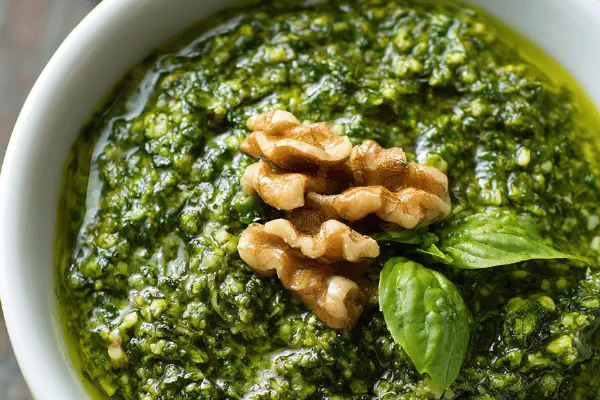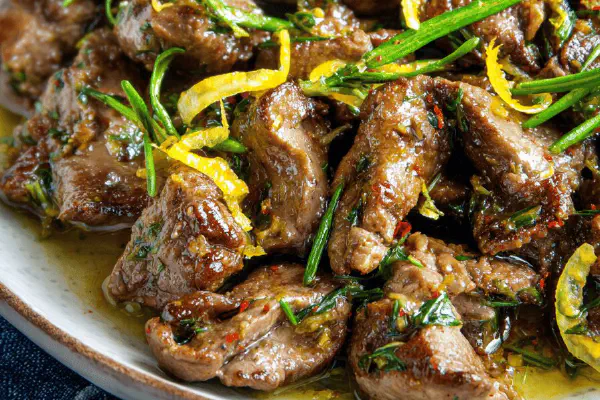Twisted Parsley Spinach Pesto

By Emma
Certified Culinary Professional
Ingredients
- 45 g (1 cup) fresh flat-leaf parsley, including stems
- 48 g (about 1 1/4 cups) baby spinach leaves
- 55 g (1/2 cup) toasted walnuts
- 90 ml (6 tablespoons) extra virgin olive oil
- 1 small clove garlic, finely minced
About the ingredients
Method
- Bring a pot of salted water to a rapid boil. Drop in baby spinach, swish gently, and remove once wilted bright green—about 20-25 seconds. Don’t overdo or leaves turn dull and slimy.
- Transfer spinach immediately to a large bowl of ice water to shock. Crisp leaves, lock in color. Drain and squeeze firmly in your hands or wrapped in a kitchen towel to squeeze out moisture. Excess water ruins texture; pesto becomes watery.
- Combine blanched spinach, parsley (stems and all for extra flavor), toasted walnuts, and garlic in food processor. Pulse a few times just to start breaking down the nuts.
- With motor running, slowly pour olive oil in a steady stream. Watch texture—want a chunky but well combined paste, not oily soup.
- Pause, scrape down sides, season with salt and freshly ground black pepper. Pulse a couple more times to incorporate.
- Taste. Add pinch lemon zest or a few drops lemon juice if it feels flat or heavy. This cut acidity brightens herbaceous notes.
- Transfer pesto to container. Drizzle thin layer olive oil on top, seals from air, keeps pesto vivid verdant green. Refrigerate if using later; best within 3 days.
- Serve slathered on toasted crostini, dolloped over pan-seared fish, or spooned on hearty buckwheat crepes. Crunchy nuts and garlicky herb punch create mouthwatering contrast.
Cooking tips
Chef's notes
- 💡 Blanch spinach quickly not more than 25 seconds. Watch the leaves turn bright green. Steam time kills color and texture. Plunge ice water right after. Cold halts cooking, locks vibrancy. Squeeze out water firmly. Damp greens dilute, thinning pesto and ruining mouthfeel. Think wringing a damp sponge till just moist. Skipping this leads to watery sauce. Repeat practice to develop feel for exact timing and squeeze pressure.
- 💡 Add olive oil with food processor running—steady slow stream. Too fast, you get oily soup. Texture change is your cue—chunky but well combined. Stop often, scrape sides with spatula. Nuts and parsley hide in processor corners. Pulsing keeps texture alive, not puree or glue. Garlic finely minced, never crushed whole cloves raw. High raw garlic burns taste buds, acrid sharpness. Toast walnuts dry in pan first; heat releases those nut oils, adds depth and aroma. Don’t skip this step unless nuts pre-toasted.
- 💡 Lemon zest or few drops lemon juice comes after blending. Cuts heaviness without watering down. Citrus lifts herbal notes, brightens paste. Too much acid makes clumpy, watery pesto—add little at a time. Salt and cracked black pepper season last to gauge balance. Freshly ground pepper adds subtle crunch and bite missing in pre-ground. Parsley stems add hidden flavor here; stems aren’t filler. Toss them in whole, finely minced alongside leaves.
- 💡 If pesto feels thin even after squeezing spinach, extend drying time. Lay greens on kitchen towel or spin longer in salad spinner. Moisture kills texture, flavor concentration. Garlic can be heated gently in oil before adding if bite too sharp. Raw garlic means freshness but harsh if overused. Use minimal quantities finely minced. Cold pressed extra virgin olive oil preferred for fruity brightness and body. Half oil can swap walnut oil for nuttier flavor, especially if richness feels flat.
- 💡 Storage matters. Cover pesto with thin olive oil film on top. Prevents oxidation, staves off browning and off-flavors. Refrigerate in airtight containers; uses best within 3 days before flavor dulls and texture softens. Freeze in small portions if needed, sealed and cold-packed to avoid discoloration. Texture changes a bit but retains flavor mostly. When reheating or using from freezer, stir in thin olive oil layer again for freshness revival.
Common questions
How long to blanch spinach?
About 20-25 seconds max. Watch color shift fast bright green. Too long = dull, slimy leaves. Ice bath stops cooking instantly. No waiting, no guesswork.
Can I substitute walnuts?
Yes, toasted pecans or even pine nuts work. Pecans sweeter, change flavor profile. Pine nuts bring creamy texture but pricier. Toast nuts dry for best aroma before blending. Avoid raw nuts unless crunch wanted.
Why is my pesto watery?
Most likely too much moisture from unpressed spinach. Squeeze firmly or dry longer on towels. Water dilutes oils and flavors. Also check if too much lemon juice or acid added. Try thicker nuts or less oil fast added.
How to store leftover pesto?
Refrigerate in sealed jar. Top with thin olive oil layer to block air. Keeps vibrant 2-3 days. Freeze in small containers for month(s). Defrost slowly, stir in fresh oil afterward. Avoid metal lids touching pesto to prevent discoloration.



